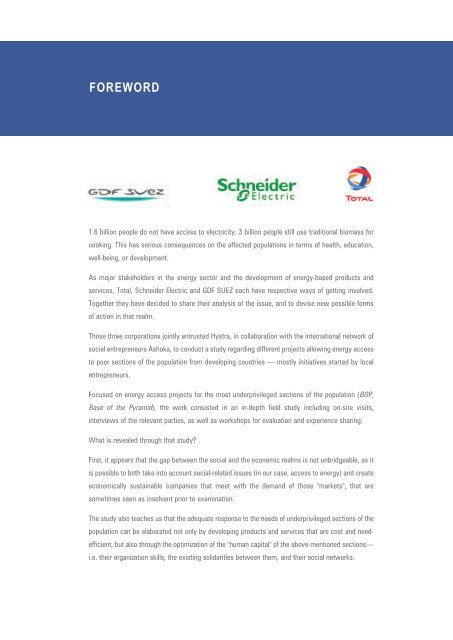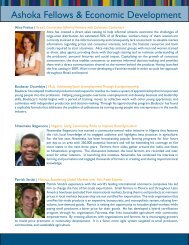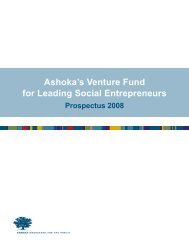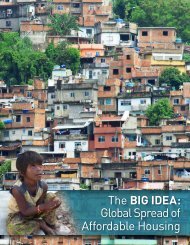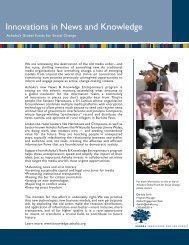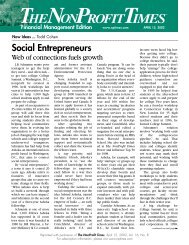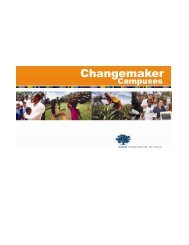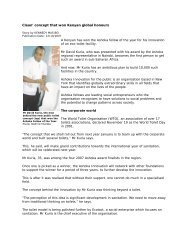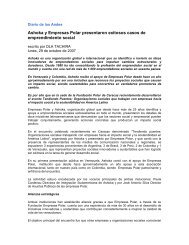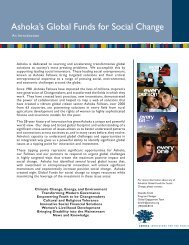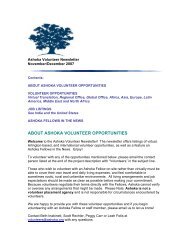Access to Energy for the Base of the - Ashoka
Access to Energy for the Base of the - Ashoka
Access to Energy for the Base of the - Ashoka
You also want an ePaper? Increase the reach of your titles
YUMPU automatically turns print PDFs into web optimized ePapers that Google loves.
FOREWORD<br />
1.6 billion people do not have access <strong>to</strong> electricity. 3 billion people still use traditional biomass <strong>for</strong><br />
cooking. This has serious consequences on <strong>the</strong> affected populations in terms <strong>of</strong> health, education,<br />
well-being, or development.<br />
As major stakeholders in <strong>the</strong> energy sec<strong>to</strong>r and <strong>the</strong> development <strong>of</strong> energy-based products and<br />
services, Total, Schneider Electric and GDF SUEZ each have respective ways <strong>of</strong> getting involved.<br />
Toge<strong>the</strong>r <strong>the</strong>y have decided <strong>to</strong> share <strong>the</strong>ir analysis <strong>of</strong> <strong>the</strong> issue, and <strong>to</strong> devise new possible <strong>for</strong>ms<br />
<strong>of</strong> action in that realm.<br />
Those three corporations jointly entrusted Hystra, in collaboration with <strong>the</strong> international network <strong>of</strong><br />
social entrepreneurs <strong>Ashoka</strong>, <strong>to</strong> conduct a study regarding different projects allowing energy access<br />
<strong>to</strong> poor sections <strong>of</strong> <strong>the</strong> population from developing countries — mostly initiatives started by local<br />
entrepreneurs.<br />
Focused on energy access projects <strong>for</strong> <strong>the</strong> most underprivileged sections <strong>of</strong> <strong>the</strong> population (BOP,<br />
<strong>Base</strong> <strong>of</strong> <strong>the</strong> Pyramid), <strong>the</strong> work consisted in an in-depth field study including on-site visits,<br />
interviews <strong>of</strong> <strong>the</strong> relevant parties, as well as workshops <strong>for</strong> evaluation and experience sharing.<br />
What is revealed through that study?<br />
First, it appears that <strong>the</strong> gap between <strong>the</strong> social and <strong>the</strong> economic realms is not unbridgeable, as it<br />
is possible <strong>to</strong> both take in<strong>to</strong> account social-related issues (in our case, access <strong>to</strong> energy) and create<br />
economically sustainable companies that meet with <strong>the</strong> demand <strong>of</strong> those "markets", that are<br />
sometimes seen as insolvent prior <strong>to</strong> examination.<br />
The study also teaches us that <strong>the</strong> adequate response <strong>to</strong> <strong>the</strong> needs <strong>of</strong> underprivileged sections <strong>of</strong> <strong>the</strong><br />
population can be elaborated not only by developing products and services that are cost and needefficient,<br />
but also through <strong>the</strong> optimization <strong>of</strong> <strong>the</strong> "human capital" <strong>of</strong> <strong>the</strong> above-mentioned sections—<br />
i.e. <strong>the</strong>ir organization skills, <strong>the</strong> existing solidarities between <strong>the</strong>m, and <strong>the</strong>ir social networks.


